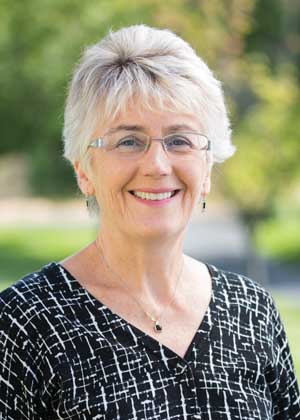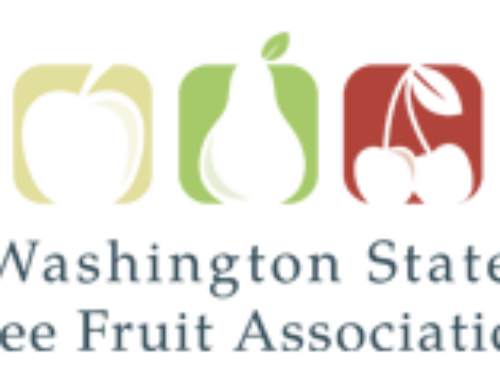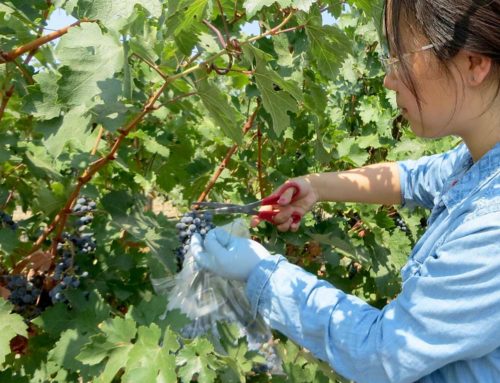
Geraldine Warner
One of the most common questions I’ve been asked during the 23 years I’ve been editor of Good Fruit Grower is, “How do you think up all those things to write about?”
I tell them lack of ideas has never been a problem; the difficulty is finding the time to write everything that needs to be written.
I wrote my first article for Good Fruit Grower in 1987 when I was freelancing for a number of publications. That was the year that Ray Hunter retired from Washington State University.
When I interviewed him, he recalled that when he arrived in 1964 as the university’s first tree fruit agent in the Columbia Basin, all he could see amid the blowing sand were fields of beans, hay, wheat, potatoes, and sugar beets. “Where are the apple trees?” he asked. “Give it time,” he was told.
I also interviewed the enthusiastic young Karen Mayles (née Lewis) soon after she arrived from Arizona in 1987 to take Hunter’s place. By then, the Columbia Basin still had less than 20,000 acres of apples compared with Yakima County’s 63,000.
There were 5,169 apple growers in the state, and prices were depressed following a huge 1987 apple crop of 68 million boxes. Growers were worried about overproduction, but Lewis was excited by the challenge of helping them to turn things around by focusing on quality as well as bins per acre.
That same year, I reported that the Washington Apple Commission moved into its new headquarters in Wenatchee and was urging growers not to use the growth regulator Alar on their Red Delicious apples in anticipation of public concerns about its safety.
The Alar scare of 1989 came as a further blow to the industry and hastened the switch to new apple varieties such as Gala and Fuji.
When I was appointed Good Fruit Grower editor in 1992, I was the only staff writer. We published 20 times a year and most (but not all) of the magazine was printed in black and white on uncoated paper.
By 1992, the number of apple growers had dropped to 4,596 as consolidation began.
I reported that New Zealand had released an exciting new variety called Pacific Rose and that pheromone confusion looked like a promising technique for controlling the key pest codling moth.
In 1994, I interviewed visionary grower Grady Auvil, who told me, “In 20 years from now, my guess is we’ll be selling 150 millions of bushels instead of 100 millions of bushels.” Washington’s 2014 apple crop would prove him dead right.
Melissa Hansen joined the staff as associate editor in 1996 and quickly became our wine grape expert while also covering cherries and many other topics. It was not until 2009 that we added a third writer, Richard Lehnert, who was based in Michigan and greatly expanded our coverage in the Midwest and Eastern United States.
Since joining the Good Fruit Grower staff, I’ve probably written close to 3,000 articles and my colleagues thousands more. As we’ve begun planning each issue of the magazine we’ve asked ourselves, “What do growers need to know?”
We’ve attended countless meetings in pursuit of articles or odd comments that might trigger story ideas. In the magazine, we’ve discussed increasing tree densities, new varieties and rootstocks, and new pests and diseases to tackle.
We’ve written about the tremendous growth of both the cherry and wine grape industries and labor shortages.
We’ve seen the Columbia Basin grow to be the preeminent apple growing district in the state with close to 60,000 acres at the last count, five years ago.
We’ve tried to keep abreast of new technologies, such as platforms, mechanical thinning and pruning devices, and harvest-assist machines. The tree fruit industry is so dynamic and evolves so rapidly that it’s impossible to keep up—though we’ve tried.
We’ve explored other parts of the world with members of the International Fruit Tree Association and experienced the camaraderie of fruit growers worldwide, unfettered by different nationalities or languages. No matter where I’ve traveled—whether to northern Japan or South America—I’ve been gratified to find that Good Fruit Grower is well known and highly respected.
We’ve relied on growers, packers, nurseries, scientists, and many others in the industry to generously share their knowledge and thoughts.
Without all the people who provide fodder for our stories, the magazine could not continue to thrive. But, above all, it’s our appreciative readers who make our work seem worthwhile and necessary.
This month I will retire from Good Fruit Grower with a feeling that, despite all we’ve written over the years, we’ve only just scratched the surface.
These are exciting times with more promising new apple varieties going in the ground and the prospect of robotic harvesting only a few years away. Only 1,450 apple growers remain in Washington state, but there’s a new crop of industry leaders with different ideas about how to be successful growing fruit.
Time might be running out for me as I approach my last deadline, but Good Fruit Grower has a new team of enthusiastic and talented writers ready to tackle that never-ending story list. •






I, along with many other fruitgrowers around the world would like to thank you for your labours in keeping the industry informed. It was a pleasure to meet you when you visited Australia. The enthusiasm for educating and informing all of us has been without doubt one of the most notable features of your time with GFG. For someone who did not grow fruit, it never ceased to astound me how easily you seemed to grasp the important part of a discussion to convey to your audience.
Well done over many years.
Kevin, Thank you for your gracious note! GFG hopes to visit Australia again soon!